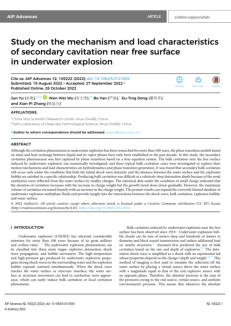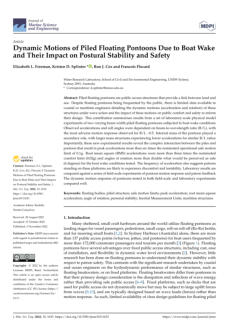Underwater construction 2022 to now





Authors:
Anudipta Chaudhuri, Rajkanya Datta, Muthuselvan
Praveen Kumar, João Paulo Davim, and Sumit Pramanik.
The demand for a modern wind energy conversion
system (WECS) has increased to achieve a suitable
alternate renewable energy source. In this paper, after a
brief introduction, the classification of WECS is reviewed
with attractive illustrations. The various mechanical
materials and electrical components of WECS are
discussed. The flow of power in WECS and its control
strategies are also described. The wind energy conversion
is carried out with a suitable controlling mechanism for
power grid integration.




Authors:
Marco Civera, & Cecilia Surace
A complete surveillance strategy for wind turbines
requires both condition monitoring (CM) of their
mechanical components and the structural health
monitoring (SHM) of their load-bearing structural
elements (foundations, tower, and blades). Therefore, it
spans both the civil and mechanical engineering fields.
Several traditional and advanced non-destructive
techniques (NDTs) have been proposed for both areas of
application throughout the last years. This document
extensively reviews these non-destructive approaches;
more than 300 scientific articles, technical reports, and
other documents are included in this review,
encompassing all the main aspects of these survey
strategies.


Authors:
Jun Yu, Jian-hu Liu, Hai-kun Wang, Jun Wang, Zhang-tao
Zhou, and Hai-bin Mao
Underwater explosion cavitation is generally simulated
using a one-fluid model based on compressible
multicomponent flows. Owing to the lack of mass and
heat transfer between liquid and vapor phases, this model
is incapable of extensively analyzing the cavitation
mechanism in an underwater explosion. In this study, the
authors extend the phase transition model provided by
Chiapolino et al. to the field of underwater explosion
cavitation. The model presents a more accurate
description of the thermodynamics of cavitation processes
involving liquid–vapor phase transition.



Authors: Y. Zhang, Y.D. Zhou, H. Wu
With the increasing significance of marine safety issues,
the studies on the underwater blast-resistant performance
of wharves, e.g., reinforced concrete (RC) caissons, has
become an urgent demand. At present, the influence of
water level on caisson subjected to underwater explosions
was studied experimentally and numerically, e.g.,
underwater explosion loading characteristics and dynamic
behaviors of caisson. Firstly, four shots of underwater
explosion test were carried out both in free field and on a
partially submerged caisson specimen, and the
overpressure and deflection-time histories, as well as the
structural damage pattern were recorded.



Authors:
Xieping Huang, Xiangzhen Kong, Jing Hu, Qin Fang
The small-scale model test is the major affordable
approach to experimentally investigate concrete gravity
dams against underwater explosions. However, results of
the small-scale model should be properly converted to the
prototype, which requires the knowledge of scaling law.
This study presented the scaling of failures of concrete
gravity dams against underwater explosion shock loading
through small-scale centrifuge tests and numerical
simulations.



Authors:
Jun Yu, Wen-Wei Wu, Jiu-Ting Dong, and Xian-Pi Zhang
Although the cavitation phenomenon in underwater
explosions has been researched for more than 100 years,
the phase transition models based on mass and heat
exchange between liquid and its vapor phases have only
been established in the past decade. In this study, the
secondary cavitation phenomenon was first captured by
phase transition based on a four-equation system.



Authors:
Elizabeth L. Freeman, Kristen D. Splinter, Ron J. Cox and
Francois Flocard
Piled floating pontoons are public access structures that
provide a link between land and sea. Despite floating
pontoons being frequented by the public, there is limited
data available to coastal or maritime engineers detailing
the dynamic motions (acceleration and rotation) of these
structures under wave action and the impact of these
motions on public comfort and safety to inform their
design. This contribution summarizes results from a set of
laboratory-scale physical model experiments of two
varying beam width piled floating pontoons subjected to
boat wake conditions.



Authors: Zhicheng Zhang, Yanbiao Zhao, Nansha Gao
Based on the recent development of underwater sound
absorption coatings, this paper analyzes the evolution of
underwater sound absorption coatings from two aspects:
traditional structures and metamaterials.



Authors: Jiahui Cui, Nguyen Duc Van, Feng Zhang, and
Yukio Hama
This paper evaluates the applicability of the minimum
required compressive strength for cold weather
concreting based on winter meteorological factors. This
study performed a compressive strength test, dynamic
elastic modulus test, hydration degree test, underwater
weighing test, and freeze-thaw test to investigate the
effect of compressive strength development at early ages
on the frost resistance of concrete.




Publisher: Parker hydraulics
Parker is a reputed manufacturer of hydraulic and
pneumatic systems.
This document provides various formulas, equations, and
conversion tables that can be used to engineer the
systems mentioned above.



Publisher: Jun Yu, Hai-tao Li, Zhen-xin Sheng, et al.
In this study, the cavitation effect induced by two charges
in underwater explosions near free surfaces is numerical
researched by two dimensional compressible multi-phase
fluids based on a four-equation system with a phase
transition model. The occurrence of the generation,
development, and collapse of cavitation in two-charge
underwater explosions near free surfaces can be captured
directly. The detailed density,pressure, and vapor volume
fraction contours during the interaction process are
obtained and can better reveal the characteristic
underlying the cavitation, free surface, and explosion
bubbles.



Publisher: Mao Zhi-yuan, Duan Chao-wei, Hu Hong-wei,
Feng Hai-yun, Song Pu
This paper summarizes the typical experiments of
underwater explosion power evaluation, discusses the
power characterization methods involved in the tests,
and focuses on the explosion bulge test of plate structure
and its corresponding dimensionless deflection
characterization means.



Authors: D Chen, L J Zhang, Y Z Lv, B H Li, H P Gu
This paper relates a series of studies are carried out on
underwater explosions with different grid sizes, so as to
obtain the corresponding
recommended grids that meet the calculation accuracy.
The influence of different water state equations on the
simulation results is discussed. The effect of artificial
viscosity coefficient on the simulation results is analyzed.
Finally, the similarity law of the model is studied to verify
the universality of the model parameters.



Authors: T Ma , J X Wang, L T Liu, H Li, Y C Gu, & Y F
Zhang
This document provides a methodology to provide a
theoretical basis for studying the shock wave propagation
and evolution generated by cylindrical charge of near-
field underwater explosion



Authors: Ming He, Shuai Zhang, Shi-ping Wang, Ze-yu
Jin, Hemant Sagar
The current work, a refined numerical study of the fl ow-
field characteristics of a large equivalent shallow-depth
explosion is carried out using a self-developed Eulerian
finite element solver.



Authors:
Dian-Long Wang, Chao-Sheng Tang , Xiao-Hua Pan, Rui
Wang , Jian-Wen Li b, Zhi-Hao Dong, Bin Shi)
Bio-carbonation of reactive magnesia cement (RMC) is a
sustainable cementing technology used to stabilize
construction and demolition wastes (CDW) in underwater
engineering projects. Experiments showed that bio-
carbonation of recycled masonry concrete effectively
stabilized construction and demolition waste underwater,
resulting in a significant increase in unconfined
compressive strength (UCS).




Authors: Grzegorz Rutkowski, Paweł Kołakowski, and
Katarzyna Panasiuk
Batychron is a device used in underwater engineering for
safe transportation and diving. This study focuses on
strength tests and analysis of the best method to join
thermoplastic polyurethane film (TPU) and polypropylene
belts for underwater use to obtain a specific buoyancy
force.


Authors:
Xiao-Ping Zhang, Shao-Hui Tang, Quan-Sheng Liu, Hao-
Jie Wang, Xin-Fang Li, Peng Chen, Hao Liu
This study analyzed the complexity of the first underwater
gas-insulated transmission line for 1000 kV power, the
Sutong GIL Yangtze River Crossing Cable Tunnel.
Engineering challenges during construction and
inspection were discussed. Key technologies developed
include embankment deformation control, gas explosion
prevention, synchronous transportation organization,
dust-free equipment installation, and robot intelligent
inspection.




Publisher:
Vasiliy E. Nikulin, Sergey G. Parshin, Alexey M. Levchenko,
Gennadiy N. Vostretsov, Ilia L. Repin
The development of underwater technologies and
exploration of Arctic and Caspian shelves involve the use
of marine metal structures made from high-strength steel.
Research on underwater wet welding is crucial for
ensuring the quality of welded joints in high-strength
steel, particularly due to factors like temperature gradient,
rapid cooling rate, stiffness conditions, microstructure
heterogeneity, residual welding stresses, and hydrogen
effusion affecting the likelihood of cold crack growth in
welded joints.



Publisher: UDECO AS - https://www.udeco.no/
The Udecom Tie-on System is a versatile tie-in system that
can handle single and multiple bores. It includes the
spool, connections, protection, and installation, all with
unique features. This system allows for loading and
installing multiple tie-in spools simultaneously. It also
facilitates the quick recovery of spools and is compatible
with connection systems from major suppliers.




Authors: Rui Yang, Qian Kong, Meng Ren, Fuquan Ji, and
Dejie Li
The process of tunnel excavation is susceptible to the
formation of segment cracks, which can result in serious
safety hazards. The objective of this study is to examine
the nature, placement, and timing of cracks in a large-
diameter subaquatic shield tunnel while also identifying
their root causes. Furthermore, this research analyzes the
connections between crack features and parameters
associated with shield tunneling processes.




Authors: Kinga Korniejenko, Szymon G ˛adek, Piotr
Dynowski, Doan Hung Tran, Magdalena
Rudziewicz, Sebastian Pose, and Thomas Grab
Additive manufacturing, or 3D printing, as it is more
commonly known, is emerging as a game-changer in
various fields, including automated construction in
challenging environments such as underwater. However,
it is not perfect, despite having been tested in these
environments. This study explores the advancements of
3D printing for underwater applications and identifies
areas for refinement and enhancement, including
technology and materials.



Authors:
Fantong Lin, Xianxiang Zhou, Jian Zhao, Lan Xiao, Lubo
Tang, Ziye Liu, and Jianshuai Wang
The authors used 3D models to study how underwater
explosions affect shell structures at the bottom of the
ocean. They looked at different shapes of these structures,
like half-spheres and half-cylinders made of reinforced
concrete. Using special software, they tested various
factors like the type of explosion, distance, and water
pressure. They found that these structures are damaged
more when hit by shock waves in water than in air.




Authors: untao Sun, Jingzhu Huang, Zhiwei He, Jiahe
Wang, Dawei Zhan, Qingxiong Zhu
The study addresses the issue of blasting vibration
generated during underwater engineering, which can
cause significant damage to the surrounding
environment. It shows that predicting the blasting peak
particle velocity (PPV), which represents the maximum
velocity of ground vibration caused by the detonation of
explosives during blasting, can be utilized to mitigate
these adverse effects.



Click on the
octopus to return to
the top of the page

Authors: Chen Fabo, He Ben, Gao Peng, Ge Xiangming,
Zhou Yong, & Chu Weijiang
This document provides insights into the impact of
installation platforms on the bearing capacity and
structural integrity of monopile foundations used in
offshore constructions. It highlights the necessity of
considering installation disturbances in the design process
to optimize construction costs and enhance safety. It
presents findings from a sensitivity analysis based on
numerical simulations, detailing the specific reductions in
bearing capacities and increases in displacements and
internal forces due to the installation platform's support
legs.



Authors:
Yuan Ma, Chaohe Chen, Tianhui Fan, and Hongchao Lu
This document explains the challenges floating offshore
wind turbines (FOWTs) face due to greater wind heeling
moments, which cause significant pitch motion and affect
structural safety and power generation efficiency. It
highlights the limitations of conventional mooring
systems, which primarily resist horizontal motion, and
introduces a new mooring system that addresses both
pitch and horizontal motion by dividing the fairleads into
two groups at different depths. It also mentions the
comparative analysis of motion responses, structural loads,
and restoring forces between the conventional and
innovative mooring systems.



Authors:
Daniel Flórez-Orrego, Cyro Albuquerque, Julio A. M. Da
Silva, Ronaldo Freire, & Silvio De Oliveira Junior
This paper compares existing cogeneration systems versus
alternative power hub setups for floating production,
storage, and offloading units (FPSOs) in the offshore oil
and gas sector. It highlights the potential benefits of
adopting centralized offshore power stations, such as
increased revenues, optimal sizing, and reduced idle
power units, while also discussing the challenges and
trade-offs related to economic feasibility, environmental
impact, and operational efficiency.



Authors: Riccardo Maria Pulselli, Matteo Maccanti, Morena
Bruno, Alessio Sabbetta, Elena Neri, Nicoletta
Patrizi, & Simone Bastianoni
This article discusses a Life Cycle Assessment (LCA) study
on the environmental performance of two types of
floating wind turbines (raft-buoy and spar-buoy) used in
offshore wind farms in the Mediterranean. The study aims
to establish a benchmark for evaluating the greenhouse
gas emissions (measured in terms of Global Warming
Potential) of these turbines, thereby aiding in the design
and validation of innovative technologies for offshore
wind energy. The results indicate that floating wind
turbines have a carbon intensity comparable to other
renewable energy sources.



Authors: Sahil Tadwalkar, Yujin Lee, and Martin Fischer
This paper investigates the current state of prefabricated
pipe spools in the construction industry, identifies
challenges associated with their implementation, and
proposes a standardized workflow to address these
challenges. It includes findings from interviews with
industry professionals and emphasizes the need for better
integration between design, fabrication, and
transportation to improve efficiency.



Authors: Dimitrios N. Konispoliatis, Dimitrios I. Manolas,
Spyros G. Voutsinas, & Spyros A. Mavrakos
This article presents a detailed analysis of a multi-purpose
floating structure designed for offshore wind and wave
energy exploitation. It describes the coupled analysis
performed in both frequency and time domains,
considering various factors such as hydrodynamic
interactions, mooring lines, Oscillating Water Column
(OWC) characteristics, and wind turbine aerodynamics. It
also provides numerical results on the structure's
hydrodynamic properties and load conditions and
investigate the impact of different installation sites on
these loads.




Authors: Fenghua Zhou, Rongwang Zhang, and Shaowei
Zhang
This article describes the design, implementation, and
functionality of a low-cost directional inertial wave sensor,
DWS19-2, outlining its integration with specific hardware
components, its capability to measure various buoy
parameters, and its application in calculating wave
parameters and spectra. Additionally, it mentions the
reporting of this data for real-time transmission and
provides details on the electrical design, onboard
processing algorithms, and validation tests conducted.



Publisher:
Shaowei Zhang , Chuan Tian, and Fenghua Zhou)
This article describes the design and optimization of a
hybrid mooring buoy observation system, named
Mooring Buoys Observation System with Benthic Electro-
Optical-Mechanical Cable (MBOSBC), for long-term deep-
sea monitoring. It explains the system's components,
particularly the Electro-Optical Mechanical (EOM) cable,
which is crucial for both mooring and energy
transmission and data between the seabed and the sea
surface. It also addresses the challenges faced by the
EOM cable under environmental loads. It describes the
mooring system's design criteria and optimization process
to ensure its long-term effectiveness and reliability.



Authors: Fei Tian, Erfeng Zhang, Chen Yang, Dehua Sun,
Weidong Shi, and Yonghua Chen
This article presents research findings on the optimal
design of the mixing flow field of submersible mixers,
specifically focusing on improving the mixing uniformity
of activated sludge in the context of water pollution
control. The text discusses using numerical simulations to
analyze the flow field characteristics of solid-liquid two-
phase flow at various installation heights. The authors also
highlight the impact of installation height on flow
patterns, particle mixing, and aggregation, providing
theoretical insights for better engineering practices.



Authors:
Zhang Baofeng, Dong Rui, Wang Gang, Wang Guojun,
and Zhang Dayong
This study focuses on the dynamic interaction between
ice and the structure, particularly in the Bohai Sea, and
explores strategies to enhance wind turbines' safety and
operational stability. The research involves analyzing a
simplified mechanical model of a damping vibration
isolation system and determining the effectiveness of
different damping ratios in controlling structural
displacement and acceleration. The findings aim to guide
the design of ice-resistant offshore wind turbine
foundations.



Authors: Fali Huo, Jie Xu, Hongkun Yang, Zhaojun Yuan,
and Zhongxiang Shen
This article describes research findings on designing and
performing a multi-point mooring system for floating
offshore wind turbines in shallow water areas (30 m–50
m depth). It focuses on the challenges posed by complex
environmental conditions and topography in shallow
waters and proposes a hybrid mooring cable scheme to
provide theoretical guidance for designing mooring
systems for floating offshore wind turbines in such
environments.



Authors: Xingda Ji, Tao Zou, Xu Bai, Xinbo Niu, and
Longbin Tao
This study analyzes the impact of initial flatness
divergence on the structural response and fatigue
damage of bolted ring flange connections in offshore
wind turbines. It involves modeling and simulating the
responses of both fixed and floating offshore wind
turbines to environmental loads. It also evaluates the
consequences of geometric imperfections on the flange
connections' structural integrity and fatigue life.



Authors: Shengjie Rui, Haojie Zhang, Hang Xu, Xing Zha,
Mengtao Xu, Kanmin Shen
This study reviews the development, installation, and
operation of various deep-sea infrastructures used to
exploit energy and mineral resources. It summarizes the
types of seabed structures and foundations, analyzes the
design requirements, marine environmental loads, and
applications of these infrastructures, identifies research
gaps, highlights the importance of marine environmental
conditions, geological conditions, and soil-structure
interactions, and suggests further research.



Authors: Mehdi Hajinezhadian & Behrouz Behnam
This study advocates for a probabilistic-based approach to
life-cycle cost (LCC) analysis in the design of offshore
platforms. The text aims to demonstrate that considering
LCC in the design process can lead to more cost-effective
and optimal structural designs over the platform's lifetime.
It highlights the potential benefits of slightly increasing
initial construction costs to significantly reduce lifetime
costs, encouraging stakeholders to adopt LCC-based
design methodologies for critical infrastructure.



Authors: Samuel Lensgraf, Devin Balkcom, Alberto
Quattrini Li
This document describes a new free-floating autonomous
underwater construction system, highlighting its
capabilities, including active ballasting for efficient
transportation of cement building blocks, its unique
combination of compressed air for buoyancy and a
battery for thrusters, and its performance in construction
trials. Additionally, the authors discuss the system's
innovative components, such as a one-degree-of-freedom
manipulator, a two-component cement block
construction system, and a simple active ballasting system.



Authors: Xue-feng Zhang, & Chun-xia Song
This study focuses on safety monitoring and real-time
early warning technology for deep water high pile
foundations of bridges. It involves investigating typical
damage characteristics, proposing early warning indices
and thresholds, and establishing an evaluation model.
The research is applied to a specific project (the Jiashao
Bridge in Zhejiang Province, China) to verify the
effectiveness of the proposed system.



Authors: Fei Tian , Chen Yang, Erfeng Zhang, Dehua Sun,
Weidong Shi, & Yonghua Chen)
This study discusses improving the performance of
submersible mixers in sewage treatment by optimizing
their installation position parameters. It aims to enhance
the treatment pool's average flow velocity and mixing
efficiency and details the use of various software tools for
multi-objective optimization. The authors indicate
significant improvements in flow velocity, mixing
efficiency, and fluid distribution, suggesting that the
optimized installation positions can lead to better
operational efficiency and economic benefits in sewage
treatment plants.




Authors: Qiushi Hu, Heng Li, Guang Wang, and Lei Li
This study combines a micro-scale three-dimensional
fractal model with a macro-scale finite element simulation
method to establish an equivalent torsional stiffness
model. It also discusses the construction of a torsional
stiffness testing platform, validates the proposed model
through experimental results, and examines the
influences of torque, installation eccentricity, and
deformation coefficient on the torsional stiffness.




Authors: Mohamed ElMenshawy, Lingzi Wu, Brian Gue,
and Simaan AbouRizk
This research project aimed to automate the pipe spool
fabrication scheduling process for industrial projects. It
explains the challenges involved in the current manual
scheduling process and proposes the development of a
reinforcement learning model to handle these tasks more
efficiently. The ultimate goal is to minimize manual
intervention and improve fabrication shops' scheduling
processes.




Authors: Z G Kornilova, G S Ammosov, D S Ivanov
This text discusses the impact of construction activities,
specifically the laying of underwater pipeline crossings, on
the turbidity and sediment dynamics of the Lena River. It
highlights the environmental and structural challenges
posed by these activities, such as increased water turbidity,
sediment discharge, and potential damage to the pipeline
due to erosion and hydrodynamic loads. It also
emphasizes the need for further studies to evaluate the
ecological impact on the river.



Authors:
Hsi-Hien Wei, Yuting Zhang, Ximing Sun, Jiayu Chen,
Shixian Li
This text provides an overview and analysis of the current
state and future potential of robotics and human-robot
collaboration in the construction industry. It highlights the
technological advancements, reviews developments,
discusses challenges, and proposes future research
directions in this field.



Authors: G S Ammosov, Z G Kornilova, Yu A Yakovlev
This text analyzes the design and structural challenges
associated with the underwater crossing of the trunk gas
pipeline (TGPL) across the river Lena in the Republic of
Sakha (Yakutia). It focuses on the impact of
hydromorphological and hydrological factors on the
pipeline's integrity, highlighting issues such as scours,
sagging, and tensile stresses that result from these
environmental conditions. The text also points out past
design and construction oversights and their
consequences on the pipeline's functionality and safety.



Authors:
Tianshuo Xu, Le Wang, Peng Zhang, Yuheng Zhou,
Kaixin Liu, Xin Feng, Yongchun Qi and Cong Zeng
This article aims to provide information about the
advancements and application of the direct pipe laying
method, combining the technical advantages of
horizontal directional drilling and pipe jacking
construction. It discusses the benefits of this method, such
as efficiency and minimal land use, and examines its
implementation through a case study. Additionally, it
analyzes technical aspects like equipment selection,
guiding control technology, and factors affecting thrust
force and trajectory deviation.



Author: V. Balaram
This paper reviews the various analytical techniques used
in the research, exploration, and analysis of Rare Earth
Elements (REE). It highlights the importance of these
techniques across different stages of REE-related activities,
discusses advancements in analytical instrumentation,
and emphasizes the use of both laboratory-based and
portable techniques for practical REE analysis to inform
readers about the current state and developments in
analytical methods for REE, with examples and
applications in research studies.




Authors: Nadia A. Genovese, Francis Andreas Lee
Kjærsgaard
This text describes the research and design process for
alternative scour protection options for a project facing
extreme environmental conditions. It details the testing
and evaluation of different solutions, such as geotextile
bags and rock bags, and the challenges encountered,
particularly with scaling and construction feasibility. It also
outlines the final composite solution adopted, combining
rock bags and an armor rock berm, highlighting the
design challenges and constructability considerations
involved.




Authors:
Ming Ju, Yang Jiang, Feihong Yun, Hongwei Chai, Xi
Chen, ingxuan Zhang, and Liquan Wang
This text intends to present a detailed analysis and
findings from a study on the dynamic behavior of
submarine pipelines during the R-lay method. It aims to
describe the methodology used, specifically a finite
element-based shell element model, and the results of
simulations regarding pipeline bending moments and
ovality. It also highlights the influence of factors such as
the pipeline's diameter–thickness ratio and material
properties on these dynamic responses.




Authors:
Haixia Gong, Zhuoran Ping, Tong Zhao, Shuping Hou,
Fuqiang Zu, Pengyue Qiu, and Jianguo Qin
This study focuses on optimizing technology for recycling
abandoned undersea pipelines. It highlights the
importance of reducing costs, minimizing ocean
pollution, and improving recycling efficiency. It details the
examination of the anchoring theory and damage
process involved in submerged pipeline recovery, and it
describes the use of a multi-objective genetic algorithm to
optimize the design of the contact body structure in
recovery tools to ensure that the optimized design can
effectively exert contact force on the pipeline's inner wall,
with specific design parameters provided as a result of
the optimization process.




Authors: O.G. Kapinos, and N.V. Tvardovskaya
This text discusses the challenges and considerations in
designing and operating pressure hydraulic transport
systems in permafrost conditions. It identifies factors
affecting the risk of hydraulic shocks in pressure pipelines,
particularly during aboveground laying in permafrost
areas. It also emphasizes the importance of preventive
measures to avoid hydraulic shocks, which are more cost-
effective than dealing with the consequences of such
events.




Authors:
Haixia Gong, Tong Zhao, Xiaofeng You, Liquan Wang,
and Feihong Yun
This paper explains the process and rationale behind
using scaled model experiments to verify the design of a
deep-sea flexible pipeline-laying system. It discusses the
need for physical simulation experiments due to the
complex marine environment. It highlights the use of
similarity theory to ensure that the scaled model
accurately represents the prototype.




Authors: Changjing Fu, Yangming Xu, and Tianlong Zhao
This document explains the risks and mechanisms
associated with water-induced disasters affecting long-
distance oil and gas pipelines, particularly those crossing
river channels. It discusses the findings from a flume
model test that investigates the impact of unsteady flow
conditions on riverbed evolution and pipeline suspension
during floods.




Authors:
Sung Youn Boo, Yoon-Jin Ha, Steffen Allan Shelley, Ji-
Yong Park, Chang-Hyuck Lim, and Kyong-Hwan Kim
This document describes a study focused on developing
and validating a new Tension Leg Platform (TLP) floating
wind platform with a 15 MW turbine for offshore wind
farms in Korea. The study aims to ensure the platform's
feasibility and resilience under extreme typhoon
conditions and to minimize pre-service costs and risks by
designing a wet-towable platform. The study also outlines
the design process, analysis, and validation against
industry standards to confirm compliance with design
requirements for the planned site.



Authors:
Xiaohe Pan, Mengzhuo Liu, Jifeng Zhu, Lipeng Huo,
Zheng Peng, Jun Liu, and Jun-Hong Cui
This document discusses the development and evaluation
of a new protocol, the Robust and Adaptive Pipeline
Medium Access Control (RAP-MAC), for underwater
acoustic networks. It highlights the protocol's features,
such as its adaptability, efficiency, and robustness, and
shares the results of simulations and sea trials that
demonstrate its effectiveness in enhancing
communication in underwater environments.



Authors:
Xiaotong Han, Liang Zhu, Xiaoxia Jiang, Wei Han Khor,
Hooi Siang Kang
This paper explains a new welding method, the flux
band-constrained arc ultra-narrow gap welding (UNGW),
for improving the quality of welded joints in underwater
cast steel pipelines. It highlights the advantages of UNGW
over traditional welding methods, describes the
experimental study conducted to optimize welding
parameters, and analyzes the microstructural and
mechanical properties of the welds. It also suggests
potential welding process improvements by manipulating
the flux band composition.



Authors: Kenneth Bisgaard Christensen, Alireza Maheri,
and M. Amir Saddiq
This study investigates the effects of ambient conditions
on cryogenic cooling times for medium-carbon steel
pipes, focusing on factors such as air velocity, ambient
temperature, and cooling medium for simulations. It aims
to validate the viability of cryogenic conditions for low-
energy fracturing in carbon steel and explores the
efficiency of a proposed cryogenic cooling and cutting
system. The research also highlights the importance of
insulating effects and discusses the trade-offs between
cooling efficiency, costs, and energy consumption.



Authors: Hongqi Ma, Haibin Xiao
This document provides an overview of the development
and implementation of intelligent construction and smart
operation technologies in the Lancang River Hydropower
Project. It summarizes the research, development, and
practical applications of these technologies, particularly in
the context of high earth–rock and roller compacted
concrete dams, and introduces specific technologies and
functions related to dam safety, engineering control,
disaster prevention, and environmental monitoring.




This internet link allows every person interested to access
and download the UK HSE research reports.
It must be emphasized that the UK HSE has been one of
the 1st official bodies to emit guidelines and laws to
improve the working conditions offshore and that its
impact remains essential.












